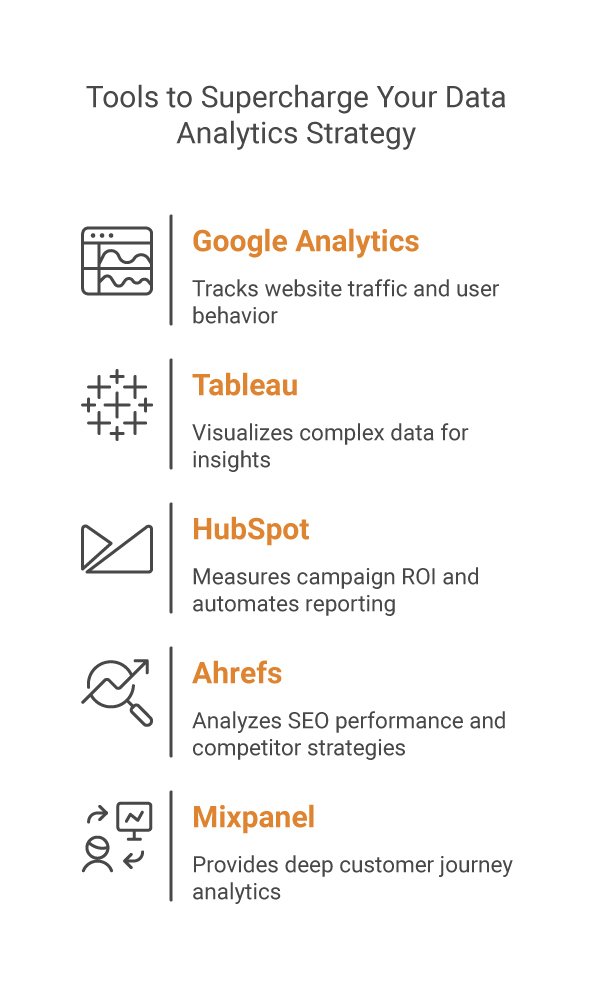
How Data Analytics is Revolutionizing Digital Marketing Strategies in 2025

May 10, 2025
In 2023, Nike’s “Choose Your Fit” campaign didn’t just use data to boost mobile sales by 40%—it crafted a story about personalized empowerment. By 2025, 73% of top brands will blend data analytics with creativity to sharpen their messaging (McKinsey, 2023). Data isn’t the enemy of storytelling—it’s the compass that guides which stories resonate, where to tell them, and how to make them unforgettable.
What is Data Analytics in Digital Marketing?
Data analytics involves collecting, processing, and interpreting data to optimize marketing efforts. It transforms raw numbers into actionable insights, enabling brands to:
- Predict customer behavior.
- Measure campaign performance.
- Personalize user experiences.
According to Google, businesses using analytics tools see 2x higher conversion rates than those relying on intuition alone.
Why Data Analytics is Non-Negotiable in 2025
1. Identifying Trends: Stay Ahead of the Curve
Why it matters: Data analytics uncovers emerging patterns, like seasonal demand spikes or shifting consumer preferences.
- Stat: Brands using predictive analytics reduce campaign costs by 25% (Forrester, 2023).
- Example: Spotify analyzes listening habits to curate personalized playlists, driving a *30% increase in user retention.
- Actionable Insight: Use tools like SEMrush to track keyword trends and align content with search intent.
2. Measuring Performance: Turn Metrics into Money
Why it matters: Without metrics, you’re marketing blind. Data reveals what’s working (and what’s wasting budget).
- Stat: Companies that track ROI metrics achieve 50% higher profitability (HubSpot, 2023).
- Example: Coca-Cola used A/B testing to optimize email campaigns, boosting open rates by 20%.
- Actionable Insight: Monitor CTR, conversion rates, and customer lifetime value (CLV) using Google Analytics.
3. Personalizing Campaigns: Speak Directly to Your Audience
Why it matters: 80% of consumers demand personalized experiences (Salesforce, 2023). Data analytics tailors content to individual preferences.
- Stat: Personalized emails generate 6x higher transaction rates (Experian).
- Example: Netflix saves $1B annually by using viewing data to recommend content.
- Actionable Insight: Segment audiences by behavior (e.g., cart abandoners) and retarget with dynamic ads.
4. Optimizing Strategies: Fix What’s Broken
Why it matters: Data pinpoints underperforming campaigns, letting you pivot quickly.
- Stat: Brands that optimize in real-time see 35% higher engagement (Adobe, 2023).
- Example: Airbnb reduced ad spend by 15% by reallocating budget to high-performing channels.
- Actionable Insight: Use heatmaps from Hotjar to identify UX friction points.
5. Discovering New Platforms: Data-Driven Exploration
The Future is Here
Why it matters: The digital landscape evolves rapidly, and clinging to legacy platforms can mean missing untapped audiences. Data analytics identifies emerging channels where your brand can shine.
Stat: Brands testing 3+ new platforms annually see 50% higher engagement rates (Gartner, 2024).
Example:
Lush Cosmetics used social listening tools to spot rising conversations about sustainability on TikTok. They launched a #NakedCampaign (packaging-free products), tailored to TikTok’s short-form video style, driving 5M+ views and a 30% sales lift in Q1 2024.
6. Improving Targeting: Reach the Right People
Why it matters: Precision targeting reduces wasted ad spend and boosts conversions.
- Stat: Data-driven ads achieve 2.5x higher CTRs (WordStream, 2023).
- Example: Glossier doubled Instagram ROAS by targeting users based on skincare searches.
- Actionable Insight: Leverage lookalike audiences on Facebook Ads to mirror top customers.
Tools to Supercharge Your Data Analytics Strategy

- Google Analytics: Track website traffic, user behavior, and conversion paths.
- Tableau: Visualize complex data for actionable insights.
- HubSpot: Measure campaign ROI and automate reporting.
- Ahrefs: Analyze SEO performance and competitor strategies.
- Mixpanel: Dive deep into customer journey analytics.
5 Steps to Implement Data-Driven Marketing
Set Clear Goals: Define KPIs Like example “Increase organic sign-ups for SaaS product trial by 25%”
Data-driven marketing starts with clear, measurable objectives. Without goals, even the best data is meaningless. Begin by aligning your KPIs with broader business outcomes. For example, if your aim is brand awareness, track metrics like organic traffic growth or social media impressions.
If conversions are the priority, use the SMART framework:
- Specific: “Increase organic traffic from Gen Z by 30%.”
- Measurable: Track via Google Analytics’ age demographics.
- Achievable: Allocate 20% of content budget to TikTok/Instagram Reels.
- Relevant: Aligns with a broader goal of capturing youth market share.
- Time-bound: Achieve within Q3 2024.
Example: A SaaS company aiming to boost trial sign-ups might set a KPI of “Increase free trial conversions by 25% in Q3.” Tools like Google Analytics or HubSpot can help track progress.
Collect Quality Data: Use CRM Systems and Cookies Ethically
Quality data is the backbone of actionable insights. Gather data from CRM systems (e.g., Salesforce), website analytics, and social media platforms—but prioritize ethical practices. Ensure compliance with regulations like GDPR and CCPA by anonymizing user data and obtaining explicit consent. Avoid “data hoarding”; focus on information directly tied to your goals.
Example: An e-commerce brand uses Shopify’s CRM to track customer purchase histories and segment audiences by buying behavior.
Analyze & Interpret: Identify Patterns (e.g., Peak Engagement Times)
Raw data becomes powerful when translated into insights. Use tools like Tableau or Google Data Studio to visualize trends. Look for patterns such as:
- Peak engagement times (e.g., 7–9 PM on Instagram).
- High-converting demographics (e.g., women aged 25–34).
- Peak engagement times: 7–9 PM on Instagram for millennials.
- Bounce rate triggers (e.g., slow-loading product pages).
- Seasonal spikes: Holiday shopping surges (e.g., 60% of annual sales occur Nov–Dec for retailers).
Example: Target analyzed decade-old purchase data to pinpoint “micro-holidays” (e.g., National Self-Care Day) and launched themed campaigns, boosting Q3 sales by 18%.
Test & Optimize: Run A/B Tests on Headlines, CTAs, and Landing Pages
Test Variables:
- Ad Placement: Instagram Stories vs. Feed (Stories drive 15% higher swipe-ups).
- Creative Format: Video ads vs. carousels (Videos retain attention 3x longer).
- Platform: Pinterest vs. TikTok for DIY audiences (Pinterest dominates intent-based searches).
Example:
- Sephora tested YouTube Shorts vs. Instagram Reels for a mascara launch. Reels drove 2x more clicks, prompting a platform-specific budget shift.
Scale Success: Double Down on High-Performing Tactics
Once you identify winning strategies, allocate resources to amplify them. For instance:
- Increase budgets for top-performing ad sets.
- Repurpose high-traffic blog content into videos or podcasts.
- Automate workflows for repeatable tasks (e.g., email drips).
Example: After discovering TikTok drove 40% of sales, a beauty brand doubled its TikTok ad spend, achieving a 60% ROI boost.
Common Pitfalls to Avoid
1. Data Overload: Focus on Metrics Tied to Business Goal
Pitfall: Forcing data to fit narratives.
- Bad Example: A beverage brand cherry-picked social media praise to justify a failed flavor launch, ignoring 80% negative sentiment in surveys.
- Fix: Let data guide stories, not dictate them.
Stat: 52% of marketers admit to “retrofit” data use (Forrester, 2023).
2. Ignoring Privacy: Comply with GDPR and CCPA to Build Trust
Privacy breaches destroy credibility. Always:
- Obtain explicit consent for data collection (e.g., cookie banners).
- Anonymize sensitive data (e.g., email addresses).
- Audit third-party tools for compliance.
Example: A healthcare brand lost 20% of its email list after violating GDPR but rebuilt trust with transparent opt-in forms.
2. Static Strategies: Continuously Update Campaigns Based on Insights
Consumer behavior and algorithms change rapidly. What worked last quarter may fail today. Regularly:
- Review campaign performance (monthly/quarterly).
- Stay updated on trends (e.g., AI-driven SEO shifts).
- Pivot quickly based on real-time data.
Example: A fashion retailer noticed declining Facebook ad ROI and shifted budgets to Instagram Reels, cutting CPA by 35%
Conclusion: Turn Data into Dominance
Data analytics isn’t a buzzword—it’s the key to digital marketing success. By 2025, brands that fail to adopt data-driven strategies will lose 30% of their market share (Gartner). Start small: audit your current campaigns with Google Analytics and prioritize one area for optimization.
Final Thought: As Neil Patel says, “Without data, you’re just another person with an opinion.
Take the first step toward smarter marketing—partner with ParMarketing.agency today.
FAQs
Data analytics can be considered a key enabler in digital marketing because it can generate practical information on how the audience reacts to any market, how the campaign is working or where trends move. It turns marketing off the narrow guess to a hard science enabling strategists to run campaigns optimally, content personalization to specific segments, and smarter resource allocation to gain the highest ROI.
Yes, data analytics is outstanding towards digital marketing. It gives a transparent basis on which all choices are made. The result is more focused and successful campaigns, increased customer satisfaction due to customisation, and gained insight into what motivates people to engage with and convert. That is the hallmark of strategic decision making.
A lot of marketing initiatives are measured and monitored through analytics. This involves the tracking of the traffic of a particular site, tracking of the user journey, tracking of social media and tracking the performance of the email campaign. With such data, the marketers are able to determine what is working, what is not, and where to tweak in order to obtain better outcomes.
Goal-oriented marketing is the type of marketing that has the ability to utilize the data to generate and enhance marketing decisions. It will be necessary in 2025 since the digital environment is crowded and highly competitive than before. There is just too much noise around so using data will always make every marketing initiative accurate, individual and effective enough to guarantee businesses to reach their target audience effectively in the competitive marketplace.
May 10, 2025
Recent Blogs





